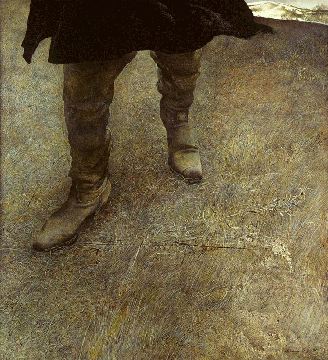[Renee Adoree and John Gilbert in King Vidor’s The Big Parade]
Reading an excerpt from David Michaelis’s biography of N. C. Wyeth in an
old Vanity Fair I came across an interesting passage. Writing about N. C.’s son Andrew, Michaelis says:
“Andy’s conception of army life had been formed by years of soaking up The Big Parade, King Vidor’s silent classic about three enlisted men in WWI, which N. C. had taken him to see as an eight-year old boy. ‘This film,’ Andrew later explained, ‘got into my bloodstream.’
Eventually he came to own a copy and would screen it four or five times a year all through his adult life. Forever linked to his deepest feelings about his father, certain frames of the film would form, without his realizing it, the basis for some of the most important images in his art.”
As an adult Andrew Wyeth eventually wrote a fan letter to King Vidor and the two men
met towards the end of Vidor’s life. Vidor made a short film about the encounter, the last film he ever made. In the film Wyeth remarks that when friends said they didn’t understand why he kept on watching The Big Parade after seeing it 180 times — literally — he replied, “You don’t understand my paintings, either.”
Two things struck me about this.
Firstly, it’s fascinating that a great artist like Wyeth, used to consciously analyzing visual images, should have created works which were unconsciously influenced by shots in a silent film. I think this speaks to the powerful ways cinematic images, particularly from silent films, can work on all of us unconsciously.
[A scene from Napoleon’s campaign in Egypt by Jean-Leon Gerome]
Secondly, I’ve always been struck by the influence of 19th-Century
academic painting on movies. The former were centrally concerned with
using spatial effects for dramatic and emotional purposes (again often
experienced in subliminal ways.) Movies, because they had greater
aesthetic resources in this area — i. e. movement in space by both
subject and camera — almost instantly spelled the end of academic
painting as a popular visual art form, and drove modern painters into
greater and greater abstraction.
The formal connections between 19th-Century academic painting and
movies is a subject that has hardly been hinted at in cinema studies to
date.

[Book illustration by N. C. Wyeth]
N. C. Wyeth kept the “cinematic” narrative-based academic style alive in
his book illustrations (as did Norman Rockwell in his magazine
illustrations) and N. C.’s son Andrew has been almost alone in keeping
elements of this style alive within the circles of modern “high art”, by
making the narrative element more ambiguous and blending the dramatic
representation of space (which is crucial to his work) with a more
pronounced abstraction of design.
In Andrew Wyeth’s obsession with The Big Parade we have a concrete example of the transmission of these oddly overlooked aesthetic connections.

[Trodden Weeds, 1951 tempera — © Andrew Wyeth]

stumbled on your site while trying to find reading on the impact of NC Wyeth on cinema. any info will be appreciated. I am simply a Wyeth fan, particularly NC.